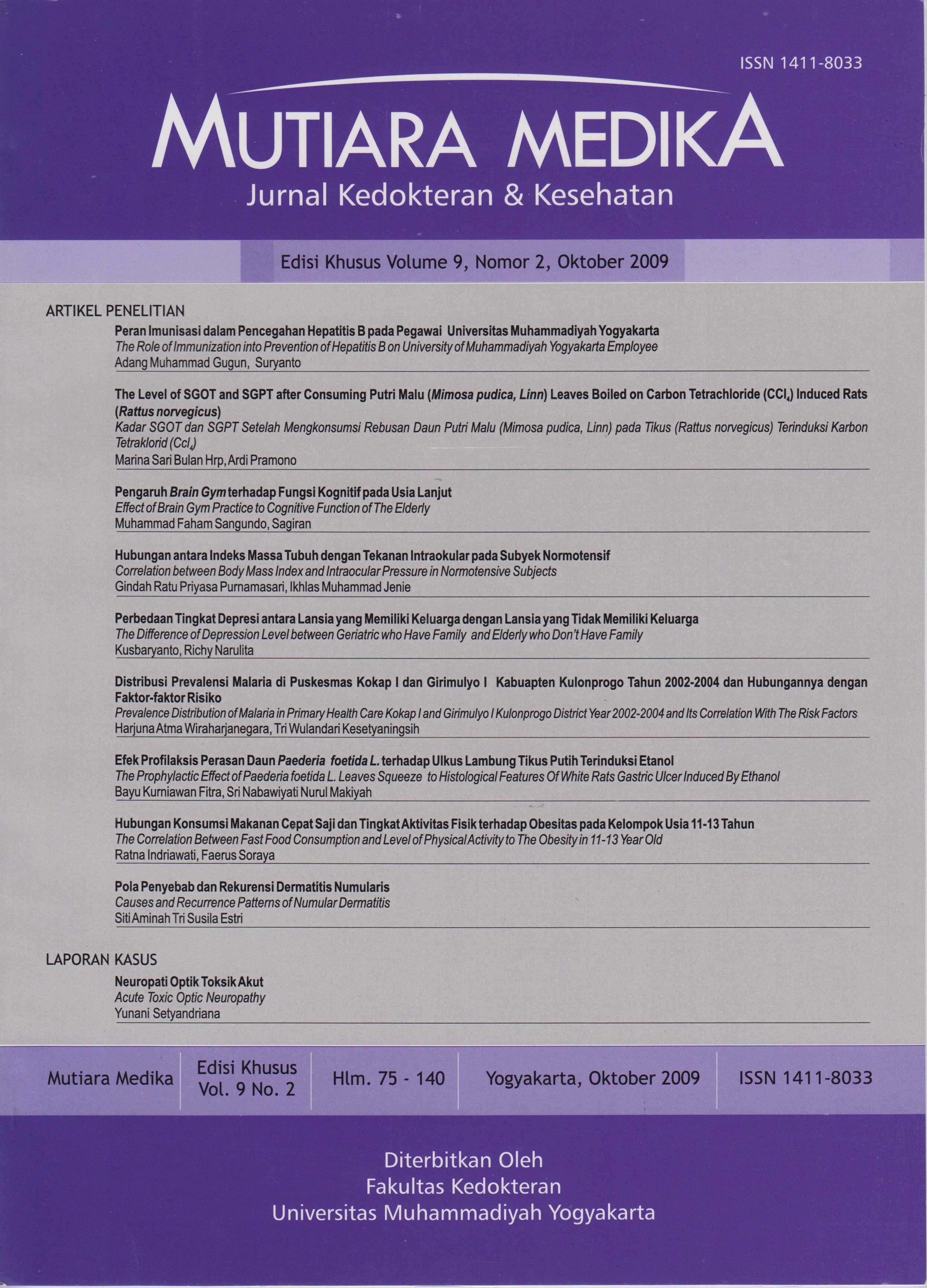The Level of SGOT and SGPT after Consuming Putri Malu (Mimosa pudica, Linn) Leaves Boiled on Carbon Tetrachloride (CCl4) Induced Rats (Rattus norvegicus)
DOI:
https://doi.org/10.18196/mmjkk.v9i2%20(s).1609Keywords:
Mimosa pudica Linn, CCl4, SGOT, SGPTAbstract
The activity testing of flavonoid compounds as antioxidant and as scavenger of free radical, from the putri malu (Mimosa pudica, Linn) leaves had been performed for prevention liver damage This study used unrandomized control trial method. Ten male Wistar rats with 150¬250 gr of body weight were divided into two groups. Measuring of SGOT and SGPT before treating was taken to determine first level of SGOT and SGPT. Group I as a control group was given with 1 ml aquadest orally for 9 days. Group II as a experiment group was treated 1, 890 gr for each rat/day putri malu (Mimosa pudica, Linn) leaves boiled for 9 days. In the day 10th, both of groups were induced 1 ml/of kg body weight carbon tetrachloride (CCl4) intraperitoneally. Twenty four hours after CCl-induced, measuring of serum SGOT and SGPT was done. The result showed Statistic test of independent t - test indicated that there was significant difference beetwen control group and experiment group. Grade of rate SGOT and SGPT after treatment of group control more than hight with p<0.001 (p<0.05) so it could be concluded that putri malu (Mimosa pudica, Linn) leaves boiled can be prevent liver damage greated carbon tetrachloride (CCl4) induced.
Telah dilakukan uji aktivitas hepatoprotektif penangkal radikal bebas terhadap flavonoid dari daun Putri malu (MimosaPudica, Linn.) pada tikus putih galur wistar (Rattus norvegicus) jantan induksi CCl4. Penelitian ini bertujuan mengetahui kemampuan rebusan daun putri malu (Mimosa pudica, Linn) sebagai hepatoprotektor dan menurunkan efek radikal bebas akibat perlakuan hepatotoksin CCl4. Penelitian ini menggunakan metode unrandomized control trial. Sepuluh ekor tikus putih galur wistar (Rattusnorvegicus) jantan dengan berat badan 150-250 gram dibagi menjadi dua kelompok. Pengukuran kadar SGOT dan SGPT sebelum perlakuan dilakuan untuk mengetahui kadar SGOT dan SGPT awal. Kelompok pertama sebagai kelompok control diberikan 1 ml aquades secara oral selama 9 hari. Kelompok kedua sebagai kelompok uji diberi rebusan daun putri malu (Mimosapudica, Linn) sebanyak 1,890 mg/ekor/hari selama 9 hari. Pada hari ke-10 kedua kelompok diinduksi 1 ml/kgBB CCl4 secara intraperitoneal. Dua puluh empat jam setelah induksi CCl4 dilakukan pengukuran kadar SGOT dan SGPT pada kedua kelompok. Hasil uji statistik independent t- test menunjukkan terdapat perbedaan yang signifikan antara kelompok control dan kelompok uji. Kadar rata-rata SGOT dan SGPT setelah perlakuan pada kelompok kontrol lebih tinggi dari pada kelompok uji dengan nilai p<0,01 (p<0,05) sehingga dapat disimpulkan rebusan daun putri malu (Mimosapudica, Linn) dapat mencegah kerusakan hepar akibat induksi karbon tetraklorida.
References
Carbon Tetrachloride. (1999). World Health Organization. Diakses 29 April 2008, dari http://www.who.int.
Juliet, F. (2008). Putri malu (Mimosa pudica, Linn). Diakses 15 April 2008, dari http://www.putri malu.com/primary/ articles
Linawati, Y., Apriyanto, A., Susanti E., Wijayanti, I., Donatus, I.. (2007). Efek Hepatoprotektif rebusan herba putri malu (Mimosa pigra, Linn). Pada tikus terangsang parasetamol. Diakses 29 April 2008, dari http:// www.clinchem.org/cgi/content/abstract/ 43/7/1209
Sofia, D. (2008). Antioksidan dan Radikal Bebas. Diakses ,dari http:// www.chemistry.org
Flavonoid. (2008). Wikipedia Diakses 13 Nopember 2007, dari http:// en.wikipedia.org/wiki/Flavonoid
Lenny, S. (2006). Senyawa Flavonoida, Fenilpropanoida, dan Alkaloida. Diakses 14 Nopember 2008, dari http:// library. usu.ac.id/download/fmipa/ 06003489.pdf
Downloads
Published
Issue
Section
License
Copyright
Authors retain copyright and grant Mutiara Medika: Jurnal Kedokteran dan Kesehatan (MMJKK) the right of first publication with the work simultaneously licensed under an Attribution 4.0 International (CC BY 4.0) that allows others to remix, adapt and build upon the work with an acknowledgment of the work's authorship and of the initial publication in Mutiara Medika: Jurnal Kedokteran dan Kesehatan (MMJKK).
Authors are permitted to copy and redistribute the journal's published version of the work (e.g., post it to an institutional repository or publish it in a book), with an acknowledgment of its initial publication in Mutiara Medika: Jurnal Kedokteran dan Kesehatan (MMJKK).
License
Articles published in the Mutiara Medika: Jurnal Kedokteran dan Kesehatan (MMJKK) are licensed under an Attribution 4.0 International (CC BY 4.0) license. You are free to:
- Share — copy and redistribute the material in any medium or format.
- Adapt — remix, transform, and build upon the material for any purpose, even commercially.
This license is acceptable for Free Cultural Works. The licensor cannot revoke these freedoms as long as you follow the license terms. Under the following terms:
Attribution — You must give appropriate credit, provide a link to the license, and indicate if changes were made. You may do so in any reasonable manner, but not in any way that suggests the licensor endorses you or your use.
- No additional restrictions — You may not apply legal terms or technological measures that legally restrict others from doing anything the license permits.






